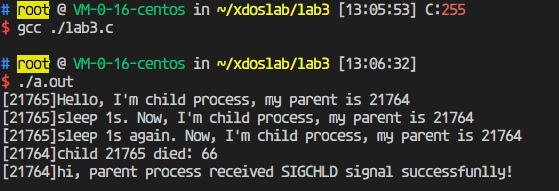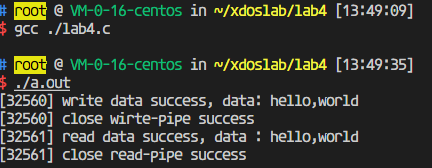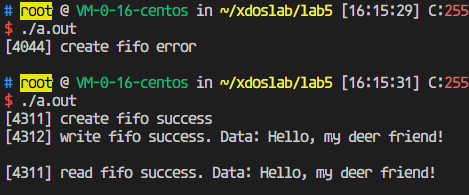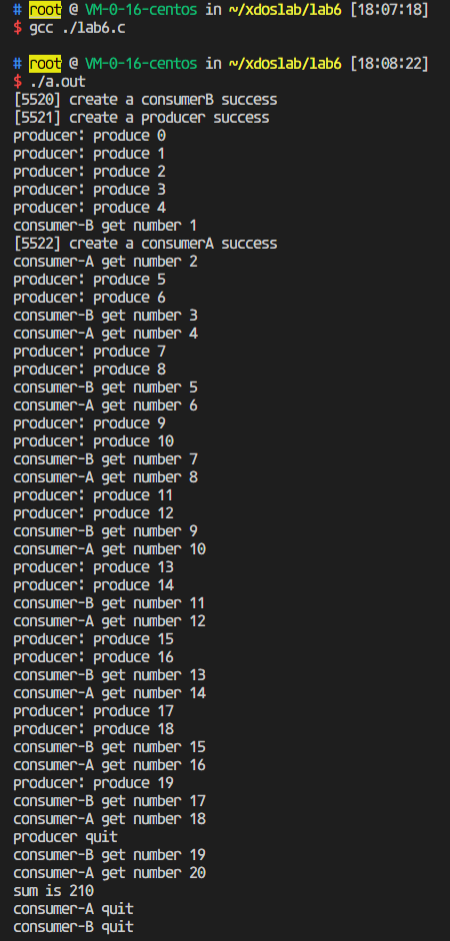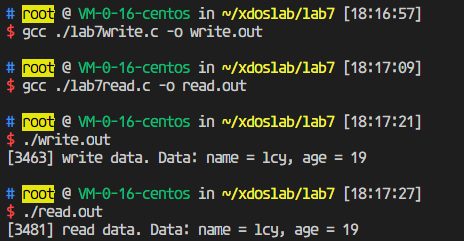创建进程
学会通过基本的 Windows 或者 Linux 进程控制函数,由父进程 创建子进程,并实现父子进程协同工作。
VC++6.0 或 Linux 操作系统
创建两个进程,让子进程读取一个文件,父进程等待子进程读取 完文件后继续执行,实现进程协同工作。 进程协同工作就是协调好两个进程,使之安排好先后次序并以此 执行,可以用等待函数来实现这一点。当需要等待子进程运行结束 时,可在父进程中调用等待函数。
代码如下,分析在注释中
#include<stdio.h>
#include<unistd.h>
#include<sys/types.h>
int main() {
//fork a process
pid_t p = fork();
if (p < 0) {
printf("create process eroor\n");
return;
}
if (p) {
//p > 0 means that this process is parent process, so just wait for child process.
pid_t childPid = waitpid(p, NULL, 0);
printf("[%d]I'm parent process, my child process' pid is %d\n", getpid(), childPid);
return;
}else {
// p = 0 means that this process is child process, so it need to read a file.
printf("[%d]Hello, I'm child process, It' s my time to raed a damn file!\n", getpid());
FILE* f = fopen("./lab1.txt", "r");
// read 255 bytes once
char buff[255];
while(!feof(f)) {
if (fgets(buff, 255, f) != NULL){
printf("%s", buff);
}
}
printf("\n");
// don't forget to close the damn file!
fclose(f);
printf("[%d]Hello,I have finished my task about reading a file!\n", getpid());
return;
}
}感觉不错,做lab比看书有意思
线程共享进程数据
了解线程与进程之间的数据共享关系。创建一个线程,在线程中 更改进程中的数据。
VC++6.0 或者 Linux 操作系统
在进程中定义全局共享数据,在线程中直接引用该数据进行更改 并输出该数据。
代码如下,分析在注释里
#include<stdio.h>
#include<pthread.h>
#include<unistd.h>
// sharedData is the data which can be shared from parent process to parent process's thread.
static int shareData = 1;
// this function is the start function of the thread we create.
// We should assign this function's address when we create a thread by calling func: pthread_create.
void* thread_fn(void* args){
printf("I'm a cute thread, I'm born with args: [%s]\n", args);
printf("I can see my parent's data, it is %d !\n", shareData);
int beforeData = shareData;
shareData = 2;
printf("And I'm a evil thread, I change my parents' data from %d to %d! HaHa\n", beforeData, shareData);
return;
}
int main(){
pthread_t tid;
char args[10] = "ANewThread";
// create a thread and pass a args to it
if (!pthread_create(&tid, NULL, thread_fn, args)){
//this create function return 0 means that creating a thread sucess!
printf("[%d]I'm parent process, I've successfully created a thread %u\n", getpid(), tid);
//usirng join to wait for thread
pthread_join(tid,NULL);
printf("[%d]My boy! You change my data!!!(shared data is %d now)\n", getpid(), shareData);
return 0;
}
// if creating thread failed
printf("[%d] Oh!!No!! The most failed thing in my life is to create a thread failed\n", getpid());
return -1;
}线程是可以从进程那里共享到数据的,并且可以对其进行访问和修改。这告诉我们有时候败家子会毁了父母的家业的!
信号通信
利用信号通信机制在父子进程及兄弟进程间进行通信。
VC++6.0 或者 Linux 操作系统
父进程创建一个有名事件,由子进程发送事件信号,父进程获取 事件信号后进行相应的处理。
分析见注释
#include<unistd.h>
#include<signal.h>
#include<wait.h>
#include<sys/types.h>
#include<stdio.h>
// receive signal and handle it
void signal_handler(int signal) {
pid_t pid;
int status;
// receive signal
// param -1 means that wait any child process
// param WNOHANG means that if any child process still running, the function will directly return 0
while ((pid = waitpid(-1, &status, WNOHANG)) > 0) {
printf("[%d]child %d died: %d\n", getpid(), pid, WEXITSTATUS(status));
printf("[%d]hi, parent process received SIGCHLD signal successfunlly!\n", getpid());
}
return;
}
int main() {
// create a child process
pid_t p = fork();
if (p < 0) {
printf("create process eroor\n");
return;
}
if (p) {
// p > 0 means that this process is parentprocess
// call signal_handler
// SIGCHLD means that when child process exit, it will send a signal named SIGCHLD.
signal(SIGCHLD, signal_handler);
pause();
}else {
// p = 0 means that this process is child process
// print
printf("[%d]Hello, I'm child process, my parent is %d\n", getpid(), getppid());
sleep(1);
printf("[%d]sleep 1s. Now, I'm child process, my parent is %d\n", getpid(), getppid());
sleep(1);
printf("[%d]sleep 1s again. Now, I'm child process, my parent is %d\n", getpid(), getppid());
return;
}
}很不错。
匿名管道通信
学习使用匿名管道在两个进程之间建立通信
VC++6.0 或者 Linux 操作系统
分别建立名为 Parent 的单文档应用程序和 Child 的单文档应用程 序作为父子进程,由父进程创建一个匿名管道,实现父子进程向匿 名管道写入和读取数据。
分析见注释
#include<wait.h>
#include<stdio.h>
#include<unistd.h>
#include<string.h>
#include<sys/types.h>
#define MAX_LINE 80;
int main() {
int fd[2];
if (pipe(fd) == -1 ){
// create pipe failed
printf("[%d] create pipe fail\n", getpid());
return -1;
}
// create pipe successed
// create a child process
pid_t p = fork();
if (p < 0) {
// fork a process failed
printf("[%d] fork a child process failed\n", getpid());
return;
}
if (p) {
// parent process
// close read pipe
close(fd[0]);
char buf[255] = "hello,world";
// wirte data
write(fd[1], buf, 255);
printf("[%d] write data success, data: %s\n", getpid(), buf);
// close wirte pipe
close(fd[1]);
printf("[%d] close wirte-pipe success\n", getpid());
// sleep a while
sleep(1);
} else{
// child process
// close write-pipe
close(fd[1]);
// sleep a while
sleep(1);
char buf[255];
// read data from read-pipe
read(fd[0], buf, 255);
printf("[%d] read data success, data : %s\n", getpid(), buf);
// close read-pipe
close(fd[0]);
printf("[%d] close read-pipe success\n", getpid());
}
}挺好的,能通信就是因为fork了一样的文件描述符,指向同一个匿名管道。
命名匿名管道通信
学习使用命名匿名管道在多进程之间建立通信
VC++6.0 或者 Linux 操作系统
建立父子进程,由父进程创建一个命名匿名管道,由子进程向 命名管道写入数据,由父进程从命名管道读取数据。
#include<fcntl.h>
#include<sys/types.h>
#include<stdio.h>
#include<unistd.h>
#include<sys/stat.h>
// the pipe's location
#define FIFO_SERVER "/tmp/fifoserver"
int main() {
// create fifo
if (mkfifo(FIFO_SERVER, O_NONBLOCK) == -1) {
// create fifo error
printf("[%d] create fifo error\n", getpid());
return -1;
}
// create fifo success
printf("[%d] create fifo success\n", getpid());
// fork a child process
pid_t p = fork();
if (p == -1) {
// fork error
printf("[%d] fork a child process error\n", getpid());
return -1;
}
if (p) {
// parent process
// open the fifo with readonly mode
int fd = open(FIFO_SERVER, O_RDONLY);
char buf[255];
// read data from fifo
read(fd, buf, 255);
printf("[%d] read fifo success. Data: %s\n", getpid(), buf);
// close fd
close(fd);
} else {
// child process
// open the fifo with writeonly mode
int fd = open(FIFO_SERVER, O_WRONLY);
char buf[255] = "Hello, my deer friend!\n";
write(fd, buf, 255);
printf("[%d] write fifo success. Data: %s\n", getpid(), buf);
// close fd
close(fd);
}
}很不错,通过命名管道是可以不止父子/兄弟进程之间通信,任意进程都可以哦。
信号量实现进程同步
进程同步是操作系统多进程/多线程并发执行的关键之一,进程 同步是并发进程为了完成共同任务采用某个条件来协调他们的活 动,这是进程之间发生的一种直接制约关系。本次试验是利用信号 量进行进程同步。
VC++或者 Linux 操作系统
- 生产者进程生产产品,消费者进程消费产品。
- 当生产者进程生产产品时,如果没有空缓存区可以用,那么生产者进程必须等待消费者进程释放一个缓存区。
- 当消费者进程消费产品时,如果缓存区中没有产品,那么消费者进程将被阻塞,直到新的产品被生产出来。
#include<stdlib.h>
#include<stdio.h>
#include<sys/sem.h>
#include<sys/mman.h>
#include<unistd.h>
#include<sys/shm.h>
#include<sys/wait.h>
#define MAXSEM 5
int full_id, empty_id, mutex_id;
struct sembuf P,V;
typedef struct {
int get;
int set;
int array[5];
int sum;
}data;
int p (int sem_id) {
P.sem_num = 0;
P.sem_op = -1;
P.sem_flg = SEM_UNDO;
if (semop(sem_id, &P, 1) == -1) {
perror("p error");
return 0;
}
return 1;
}
int v (int sem_id) {
V.sem_num = 0;
V.sem_op = 1;
V.sem_flg = SEM_UNDO;
if (semop(sem_id, &V, 1) == -1) {
perror("v error");
return 0;
}
return 1;
}
union semun{
int val; //cmd为SETVAL时,用于指定信号量值
struct semid_ds *buf; //cmd为IPC_STAT时或IPC_SET时生效
unsigned short *array; //cmd为GETALL或SETALL时生效
struct seminfo *_buf; //cmd为IPC_INFO时生效
};
int getval(int sem_id) {
union semun u;
return semctl(sem_id, 0, GETVAL, u);
}
int main(){
pid_t producer;
pid_t consumer_a;
// set P and V
P.sem_num = 0;
P.sem_op = -1;
P.sem_flg = SEM_UNDO;
V.sem_num = 0;
V.sem_op = 1;
V.sem_flg = SEM_UNDO;
int number;
// create key
key_t key0 = ftok(".", 11);
key_t key1 = ftok(".", 12);
key_t key2 = ftok(".", 13);
// get three semaphore
full_id = semget(key0, 1, IPC_CREAT);
empty_id = semget(key1, 1, IPC_CREAT);
mutex_id = semget(key2, 1, IPC_CREAT);
// set semaphore value
union semun arg;
// set full-sem val
arg.val = 0;
if (semctl(full_id, 0, SETVAL, arg) == -1) {
perror("semctl setval-full error");
return -1;
}
// set empty-sem val
arg.val = MAXSEM;
if (semctl(empty_id, 0, SETVAL, arg) == -1) {
perror("semctl setval-empty error");
return -1;
}
// set mutex-sem val
arg.val = 1;
if (semctl(mutex_id, 0, SETVAL, arg) == -1) {
perror("semctl setval-mutex error");
return -1;
}
// create share memory
// create a key
key_t key3 = ftok(".", 14);
if (key3 == -1) {
printf("[%d] create key error\n", getpid());
return -1;
}
// create key success
// create a shared memory
int s = shmget(key3, sizeof(data), IPC_CREAT);
if (s == -1) {
// create a shared memory error
printf("[%d] create a shard memory error\n", getpid());
return -1;
}
// create a shared memory success
// connet its virtual address to this shared memory address
char* address = (char *)shmat(s, NULL, SHM_EXEC);
// read data from shared memory
data* d = (data*)address;
// we should init data first
d->set = 0;
d->get = 0;
d->sum = 0;
int j;
for(j = 0; j < MAXSEM; j++) {
d->array[j] = 0;
}
producer = fork();
if (producer == -1) {
printf("[%d] create producer process error\n", getpid());
return -1;
}
if (producer) {
// parent process
// create consumerA process
consumer_a = fork();
if (consumer_a == -1) {
printf("[%d] create consumerA process error\n", getpid());
return -1;
}
if (consumer_a) {
// consumerA' parent, we call it consumerB
printf("[%d] create a consumerB success\n", getpid());
while(1) {
// p full, if now full-sem == 0, it will be blocked, because there is nothing to consume.
p(full_id);
// then p mutex-sem
p(mutex_id);
// critical area code
if(d->get == 20){
// if all consumers have took data 100 times
v(mutex_id);
v(full_id);
break;
}
d->sum += d->array[(d->get) % MAXSEM];
printf("consumer-B get number %d\n", d->array[(d->get) % MAXSEM]);
d->get++;
if (d->get == 20) {
printf("sum is %d\n", d->sum);
break;
}
// v mutex-sem and empty-sem
v(mutex_id);
// v empty, if now producer is blocked in p(empty_id), and now we v(empty_id), then producer can continue to produce because the consumer consume a procuct just now.
v(empty_id);
// sleep a while
sleep(1);
}
printf("consumer-B quit\n");
} else{
// consumerA
printf("[%d] create a consumerA success\n", getpid());
while(1) {
// p full, if now full-sem == 0, it will be blocked, because there is nothing to consume.
p(full_id);
// then p mutex-sem
p(mutex_id);
// critical area code
if(d->get == 20){
// if all consumers have took data 100 times
v(mutex_id);
v(full_id);
break;
}
d->sum += d->array[(d->get) % MAXSEM];
printf("consumer-A get number %d\n", d->array[(d->get) % MAXSEM]);
d->get++;
if (d->get == 20) {
printf("sum is %d\n", d->sum);
break;
}
// v mutex-sem and empty-sem
v(mutex_id);
// v empty, if now producer is blocked in p(empty_id), and now we v(empty_id), then producer can continue to produce because the consumer consume a procuct just now.
v(empty_id);
// sleep a while
sleep(1);
}
printf("consumer-A quit\n");
}
} else {
printf("[%d] create a producer success\n", getpid());
int i;
for(i = 0; i < 20; i++) {
// produce process
// p empty, if now empty-sem == 0, it will be blocked
p(empty_id);
p(mutex_id);
printf("producer: produce %d\n", d->set);
d->array[d->set % MAXSEM] = i + 1;
d->set++;
v(mutex_id);
// v full
v(full_id);
}
// sleep a while
sleep(1);
printf("producer quit\n");
}
sleep(5);
if (producer && consumer_a) {
union semun n;
semctl(full_id, 0, IPC_RMID, n);
semctl(empty_id, 0, IPC_RMID, n);
semctl(mutex_id, 0, IPC_RMID, n);
}
}生产者消费者模型,最重要的是什么时候阻塞,也就是需要一个值为缓存区大小的信号量,来阻塞生产者在缓存区满的时候的生产操作;并且需要一个值为0的信号量,来阻塞缓存区空的时候的消费者消费问题。以及注意保护共享内存,不要出现进程同时访问临界区的情况,这也就是为什么需要一个信号量值为1的mutex,也就是互斥锁的原因了。别的就没啥了。
共享内存实现进程通信
利用共享内存解决读写者问题。要求写者进程创建一个共享主存,并向其中写入数据,读者进程随后从该共享主存区访问数据。
write
#include<sys/ipc.h>
#include<sys/shm.h>
#include<stdio.h>
#include<unistd.h>
#include<stdlib.h>
typedef struct
{
char name[3];
int age;
} people;
int main() {
// create a key
key_t k = ftok(".", 1);
if (k == -1) {
printf("[%d] create key error\n", getpid());
return -1;
}
// create key success
// create a shared memory
int s = shmget(k, sizeof(people), IPC_CREAT);
if (s == -1) {
// create a shared memory error
printf("[%d] create a shard memory error\n", getpid());
return -1;
}
// create a shared memory success
// connet its virtual address to this shared memory address
char* address = (char *)shmat(s, NULL, SHM_EXEC);
// read data from shared memory
people* p = (people*)address;
p->age = 19;
p->name[0] = 'l';
p->name[1] = 'c';
p->name[2] = 'y';
printf("[%d] write data. Data: name = %s, age = %d\n", getpid(), p->name, p->age);
// disconnet the shared memory
shmdt(address);
}read
#include<sys/ipc.h>
#include<sys/shm.h>
#include<stdio.h>
#include<unistd.h>
#include<stdlib.h>
typedef struct
{
char name[3];
int age;
} people;
int main() {
// create a key
key_t k = ftok(".", 1);
if (k == -1) {
printf("[%d] create key error\n", getpid());
return -1;
}
// create key success
// create a shared memory
int s = shmget(k, sizeof(people), IPC_CREAT);
if (s == -1) {
// create a shared memory error
printf("[%d] create a shard memory error\n", getpid());
return -1;
}
// create a shared memory success
// connet its virtual address to this shared memory address
char* address = (char *)shmat(s, NULL, SHM_EXEC);
// read data from shared memory
people* p = (people*)address;
printf("[%d] read data. Data: name = %s, age = %d\n", getpid(), p->name, p->age);
// disconnet the shared memory
shmdt(address);
}共享内存。其实就是一片内存区域,咱几个进程一起将它映射到本地的虚拟地址空间,也就是这部分内存空间我们是访问到一样的,因此可以通信。


